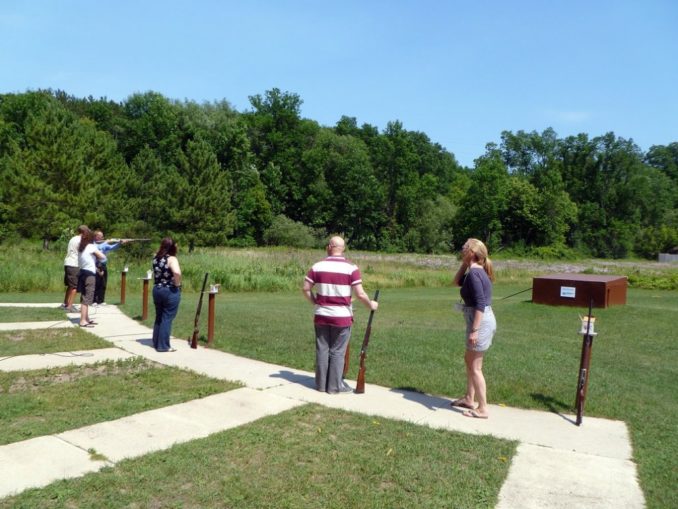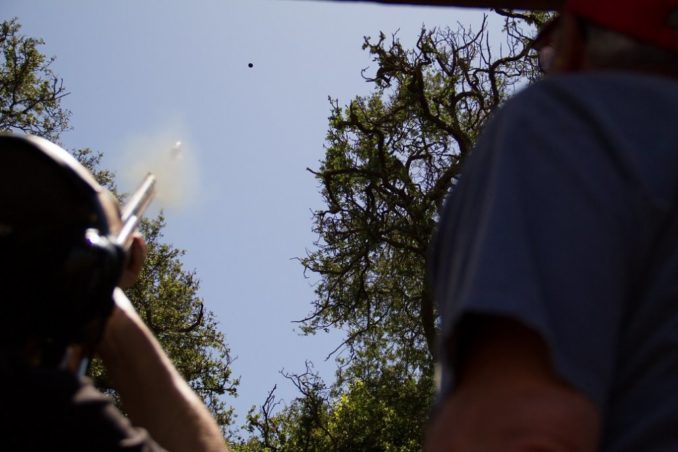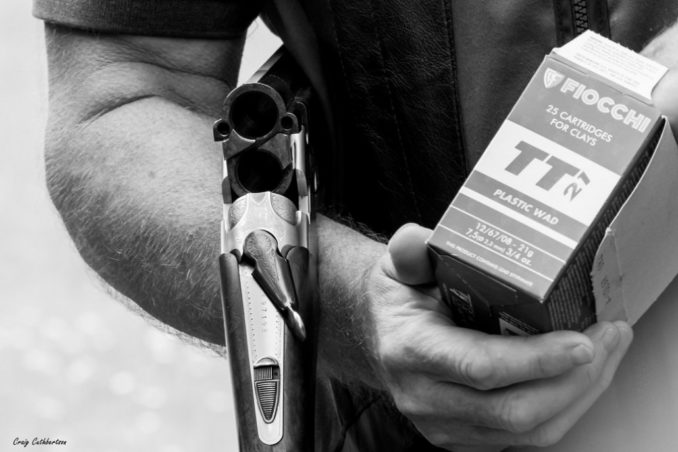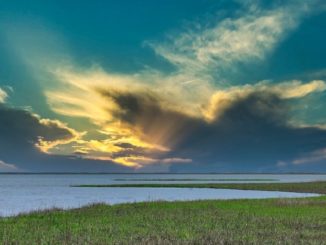A question I am often asked by people when they first find out that I shoot is… Can I have a go? My answer is invariably yes because I believe that the more people who are sympathetic to shooting sports and maybe have a laymans understanding of it, the more likely the sport will survive. Bringing new people to the sport is a duty that all shooters should therefore undertake very seriously, if they still want a chance of taking part in years to come. I worked at a major clay ground as a groundsman and then an instructor for several years, although I no longer teach clay shooting professionally, I do still coach in the field, and I really do like to get people involved if I can. So lets consider dear reader, that you would like to give it a go. Unless you can track me down in the real world, the only way I can help you is through this blog. So how then would you set about it?
Most people find their way to shooting as a hobby or sport in one of two ways. Firstly, through a family connection (the traditional method, just as I did), or through a chance encounter. What shape might this encounter take? Perhaps a Stag or Hen party activity? A workplace team bonding exercise? A visit to a try stand at your local country fair? Maybe even an open day at your local clay club that you were vaguely aware existed. It doesn’t really matter. All that concerns you now your appetite is firmly whetted, is taking the next step and turning that first go into a regular thing. The rush you got when you pulled the trigger and that black disc thingy in the sky turned to dust was a little bit infectious wasn’t it? Maybe it wasn’t beginners luck at all….

Clay pigeon shooting is actually a very accessible sport. Initially it doesn’t require any qualifications or special permits*, superior levels of physical fitness or mental aptitude. All it takes is an open mind, patience and as much or as little money as you are prepared to spend. Your local Clay Shooting ground should always be your first port of call. This could be a large professional concern with sculpted grounds and full time instructors, or it could be the once monthly straw bale shoot at the farm on the edge of your village. Most if not all of these will have a facebook page or website which will have contact details and all sorts of other info. Phone or pop into whichever club local to you appeals the most and chat with the staff. Trust me, they will be very friendly and approachable. If it floats your boat, how about a proper lesson?
*You don’t’ need a shotgun certificate to shoot under appropriate supervision at most clay grounds
Lessons will range from ‘tasters’ right through to high level expert instruction. Tasters or try days involve a very rudimentary introduction, where you will be walked through the safety and theory, before trying a few shots (around 25 is typical), at a small selection of targets. Expect to pay anything from £30 t0 £50, and these sort of lessons are great for establishing whether it is something you are interested in pursuing. They can be on a one to one setting, or as part of a group of similar level people. Most bigger clubs will run events like this quite regularly and are probably the best entry into the sport. There are even specific ladies and young shots days to cater for those who might feel intimidated or nervous out of a group setting, and usually last several hours with lunch and friendly competitions at the end. The next step up would be a basic lesson, which would be along similar lines, but with a greater emphasis on pulling the trigger. This will typically involve 50-75 shots, with a wider range of targets, then usually a chat about your progress and future aims. These lessons would probably be around the £60 to £80 mark, and are best taken one on one. At this juncture it is probably best to point out that the less physically able amongst you may well struggle beyond the 50 shot mark, at least when you first take it up. Sustained periods with a gun in the mounted position is tiring, even for an experience shot, and fatigue can set in without regular breaks. A good instructor will be fully aware of this, and will tailor each lesson to suit.
With regards to how quickly you progress and what your aims are, lessons can continue up to and beyond Olympic level. There are some exceptional coaches out there who are more than capable of releasing the full potential of their clients, but such ability will come at a price so be wary. There are some private instructors charging in excess of £1000 an hour, but the most you should ever expect to pay at even the swankiest of grounds should never exceed £250, and that will be an all in cost. Never rush the early stages of your training, it is the crucial time for developing muscle memory, hand eye coordination and body positioning, and neglecting these key areas is a primary reason for most newcomers giving up. The best piece of advice I can give here, is that it is better to miss well than to hit badly. If you do everything up to the point where you pull the trigger correctly, the end product will eventually come and be consistent and repeatable. Fluke a lucky few hits first time out, and you will soon become disillusioned when you can’t repeat the feat at a later date. Listen carefully to your instructor and make sure you understand what they are trying to tell you. If in doubt, ask.
On the subject of instructors, like most things in life, it takes all sorts. At a minimum, you want them to have been accredited by a recognised shooting organisation. The main three are the CPSA (Clay Pigeon Shooting association, the sports regulatory body), APSI or the Association of Professional Shooting Instructors (sort of like the unofficial union for Shooting Instructors), and the BASC (British Association for Shooting and Conservation), who as the name suggests are an umbrella organisation for shooting sports. They all run instructor courses, and at the very least guarantee a minimum standard for instruction and coaching. Some coaches will be accredited by more than one body, and they tend to be the better ones, but it doesn’t necessarily follow that an ‘unqualified’ coach is any less capable of teaching you to shoot, my own father for one did a pretty good job with me. Find a coach that you get on with, and stick with them, and they will do the rest.

Clay Pigeon Shooting can be a confusing sport for the uninitiated, with its multitude of disciplines and classes. At the beginner level, this is irrelevant because you will most likely only see a small variety of targets until you are consistently hitting them. Most grounds will offer a good selection of ‘birds’ over several ‘stands’ with every level of difficulty catered for, and a good instructor will hopefully have at least four different targets that cover all the basics on which to teach. Repetition is important in the early stages of learning the sport for a number of reasons, so get used to seeing the same thing over and over again until you smoke it every time. The best targets to learn on are as follows:
- Decoy – This is where a clay is launched high into the air in a slightly incoming trajectory, and appears to hang momentarily at the apogee of its flight before falling rapidly. The distance can be varied from 10 yards out to 40 and beyond, and is an excellent first target as it presents face on (so a whole side can be seen) and requires minimal gun movement.
- Incomer – These are fired towards the shooter at around a 10 or 15 degree angle to either one side or the other, hitting the ground a few yards in front of the shooter, and are usually low to the ground (around waist height). The distance at which they are launched can be varied, but easier targets tend to be seen for longer and therefore come from further away. These are one of the most versatile targets and are an excellent introduction for shooting
- Going away – The sister target to the incomer. These are also a very versatile target which is designed to mimic walked up game shooting. They can be set up to fire anywhere between almost horizontal and almost vertical, and can be made easy or difficult by the distance from the shooting position and the speed of the clay. Probably one of the most common type of targets at any clay ground.
- Driven – These come straight at you (or slightly to one side or the other) and pass over your head. They are designed to simulate a pheasant, partridge or grouse in flight and as such can be found at all heights from just over head height, to as far as your shot can reach, and at varying speed. Some instructors like this target for beginners, if their clients main aim is to take up live quarry shooting, and I personally find it quite an easy one to teach, but it requires a greater level of technique so is not suitable for everyone.
- Crossers – Again, a highly variable target, which can range from straight crossers (left to right or vice versa), quartering (where they cross in front of you but at an angle, and can be incoming or going away), looped (where the clay is presented face on rather than side on and follows an arched trajectory), rising or falling and any height from stratospheric to ground level. These can be the most difficult type of presentation to master as they require experience of forward allowance or ‘lead’*, whereas the first three targets at the beginner stage require minimal gun movement and are taken more or less by firing straight at the clay, at least for the beginners).
*The theoretical gap between the target and where you point your barrels , required to hit a moving target. This is an advanced concept and one that many beginners struggle with as it is a very individual thing based on many factors such as perception, movement speed and technique. It only comes with experience, but it is something I will go into in greater detail in a later article.

What about the clays themselves? They are made of a mixture of pitch and rock dust, which is usually coloured black or dark brown, but can be painted in any shade depending on intended use and conditions. There are three main sizes in use in the UK and these are Standard (with a diameter of 110mm) Midi (90mm) and Mini (60mm). The most common format is a saucer shape, but flat ones (battues) that jink and move in the air, and clays with reinforced rims (Rabbits) that are designed to roll along the ground will also be encountered. Special starburst clays that contain a flash powder or paint are also available as special use items. Standard are by far the most common and present the most reliable and repeatable targets, so will account for most of the beginners first shots.
Now you know a little about having a lesson, finding a person to teach you, and what sort of targets to expect. What about the hardware? Obviously, you need a gun to shoot so lets talk about them, and all the other equipment you may encounter as a newcomer to the sport. Shotguns come in various configurations and in several calibres. 95% of beginners will only ever use an over and under (O/U), where the barrels are stacked vertically. There are a couple of reasons for this. Firstly, felt recoil is lower in O/Us due to their greater mass and the way they channel the recoil into the shoulder. Secondly, the single barrel offers a clearer sight picture for most targets, making it easier to use. The calibre you will shoot will depend on your physical attributes, age and fitness, The overwhelming majority of adult men will start with the most common calibre, a 12 bore. Women and youngsters able to handle them should also ideally use a 12, although smaller calibres such as a 20 or 28 bore are available, but their lighter weight makes for greater recoil, meaning that lighter cartridges (and less weight of shot) are required to compensate. I will talk about other types of gun another time. Cartridges will probably be your greatest expense over your shooting lifetime if you take up the sport, with 250 (a slab) costing in the region of £50 for a target load. All clay grounds stipulate shot size no greater than 7 (2.4mm) and weighing no more than 28g, so a typical clay cartridge will be filled with 340 pellets. Lighter cartridges are available, and will be more commonly used by beginners, and a lot of R&D has gone into these in recent years to raise the performance levels.

Other essential gear will include some form of hearing protection, either ear plugs or ear defenders, personal choice rules here. Safety glasses and a peaked hat of some kind are vital, and compulsory at most grounds. I can’t stress enough how important these two things are having to have administered first aid to people hit by shot or clay debris whilst hatless more times than I can remember. Some sort of padded clothing, like a coat/gilet or thick jumper helps to soak up recoil, but most instructors will have worn recoil pads in their kit that can help immensely if your shoulder is starting to feel a little sore. Other than that, everything you need will be catered for at the shooting ground. I would always recommend that you dress for the weather. If it is raining, maybe consider postponing because it can be a miserable experience standing around getting wet, and doesn’t make for the best conditions to learn. Wear decent grippy footwear that you are comfortable standing and walking around in for sustained periods of time.
Next time out I will go into the steps you need to take in progressing from beginner to intermediate. We will take a look at the different disciplines of clay shooting, what their intended purpose is, and some of the techniques required to prosper in them. I shall also take a more in depth look at some of the equipment you might encounter on your journey around a typical shooting ground. I hope you have enjoyed this so far and I should probably get started on the next chapter asap.

© Columba Palumbus 2021
The Goodnight Vienna Audio file
Audio Player



